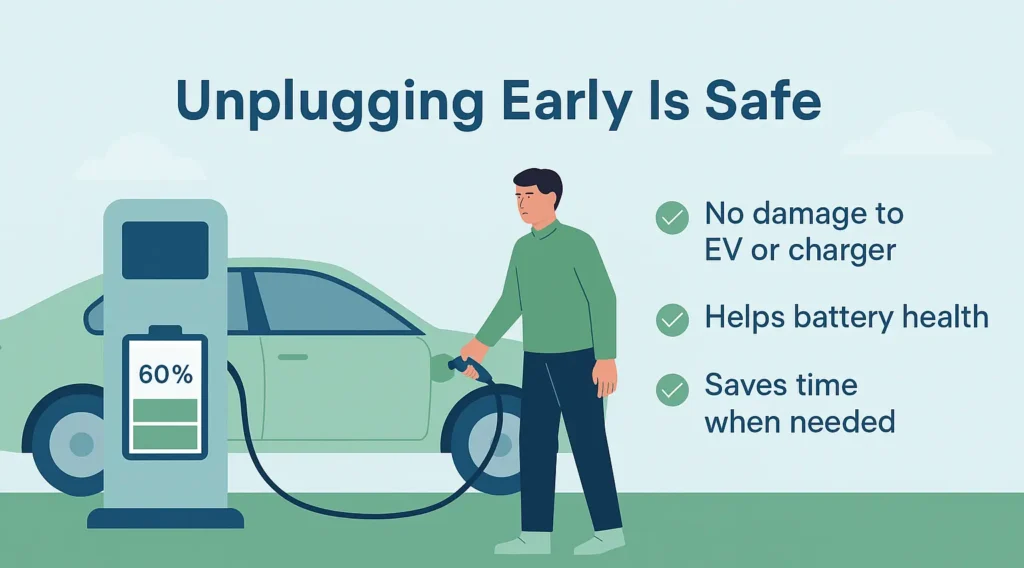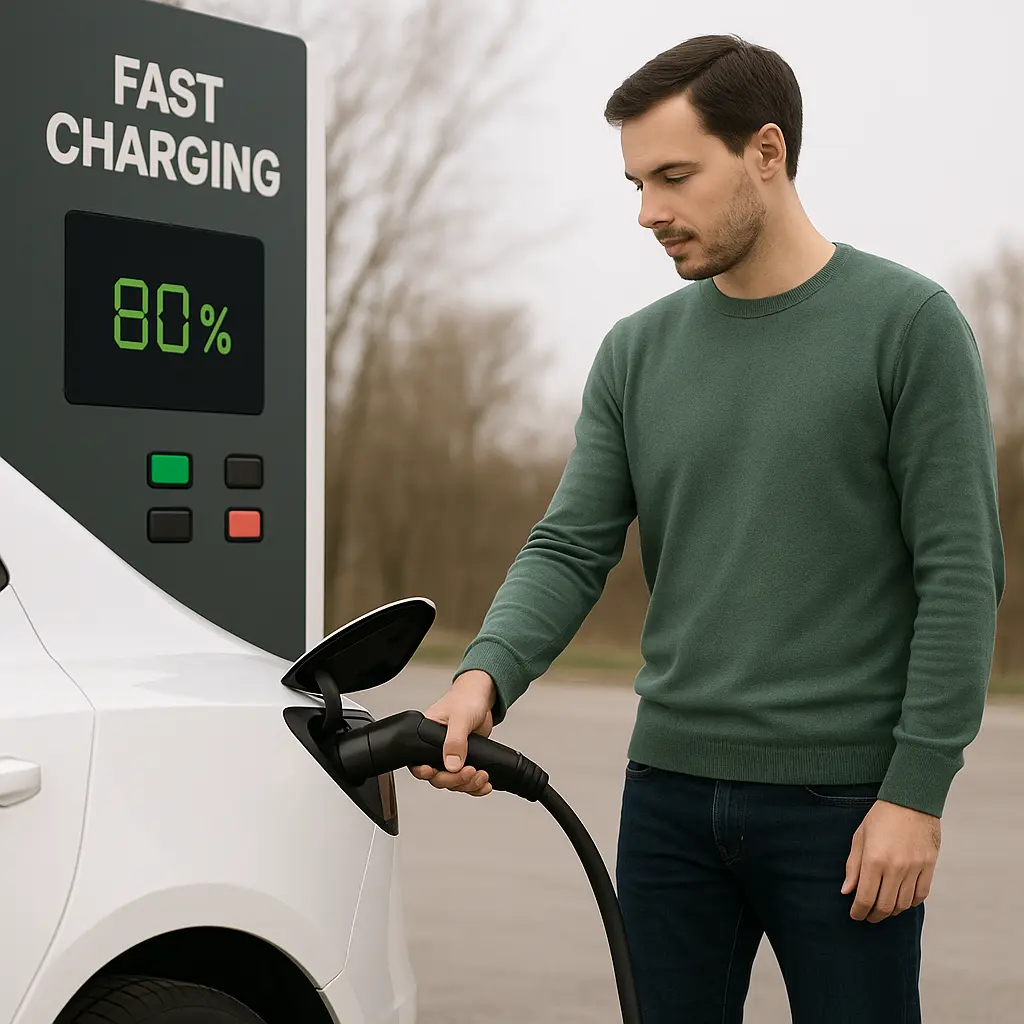Introduction
As electric vehicles (EVs) continue to grow in popularity, many new EV owners and curious drivers often wonder about the charging process. One of the common concerns is whether unplugging an EV charger before the battery is fully charged can cause any harm to the vehicle, the charger, or the battery. The short answer is: no, it generally won’t cause any damage. However, there are a few important things to consider when disconnecting early.
In this article, we’ll explore what happens when you unplug an EV charger early, how it affects the EV battery, whether it impacts charging stations, and what best practices you should follow.
What Happens When You Unplug an EV Before It’s Fully Charged?
Electric vehicles are equipped with advanced Battery Management Systems (BMS) that monitor and manage the charging process. These systems allow the vehicle to safely handle partial charges and disconnections without causing harm. If you unplug the charger early — whether the battery is at 20%, 60%, or 90% — the EV will simply stop charging and retain the power already received.
This is quite similar to charging your smartphone. You don’t always wait until it’s 100%, and neither does your car require a full charge every time. Partial charging is not only safe but is often recommended by manufacturers to maintain battery health.
In fact, most EVs don’t need to be fully charged for everyday driving. If your daily commute only requires 30-40% of the battery, topping up to 70% might be more efficient and healthier for the battery in the long run.
Can It Damage the EV Battery?

A key concern for many users is battery degradation. However, unplugging early is not a cause of damage. What actually affects long-term battery health includes factors like extreme temperatures, frequent use of DC fast charging, deep discharging (0%) or keeping it at 100% for prolonged periods.
Interestingly, many EV manufacturers recommend maintaining a charge level between 20% and 80% for optimal battery life. Charging to 100% occasionally is fine, especially before long trips, but regularly doing so may speed up battery wear.
So, if anything, unplugging early and staying within the recommended range could actually benefit the longevity of your battery.
What About the Charging Station?
From the perspective of the charging station — whether AC or DC — an early disconnection poses no problems either. EV chargers communicate with the vehicle using industry-standard protocols such as CCS, CHAdeMO, or OCPP. These protocols ensure that when a user stops the session early, both the EV and charger end the charging process safely and cleanly.
The charger won’t be “confused” or “damaged” because of an early stop. It simply stops supplying power when the communication signal is terminated. The charging station’s system will log the kWh delivered and end the session.
However, some public charging stations may require users to press a “Stop” button on the screen or inside a mobile app before disconnecting the cable. This ensures the system shuts down power before the cable is removed. Failing to do so might not damage anything, but could trigger error messages or safety locks in some models.
Does Early Unplugging Waste Power or Cost More?
Another practical question is whether stopping the charging session early will lead to wasted electricity or unnecessary costs. Generally, no.
EV charging is almost always billed based on the actual amount of energy delivered, measured in kilowatt-hours (kWh). If you unplug after 8.3 kWh of charging, that’s all you’ll pay for — not a flat fee or the full battery capacity.
However, at public stations, there may be idle fees after your EV reaches 100% or a set time limit. These fees encourage drivers to move their cars promptly to free up space. In that case, unplugging early can help save money, especially if your vehicle is already sufficiently charged for your needs.
For home chargers, where you control the electricity bill, early unplugging has no negative financial effect. In fact, some users schedule their home charging to stop at 80% as a standard practice for battery preservation
Best Practices for Safely Disconnecting an EV Charger
While unplugging early is generally safe, following proper steps ensures the process is smooth and avoids triggering system alerts:
Use the Stop Button or App (If Available): Some public chargers require you to manually stop the session via a screen or app. Always follow the procedure to avoid abrupt disconnection.
Wait for the Charging Session to End: Ensure the vehicle has stopped drawing current before removing the plug. Most EVs and chargers will show a “charging stopped” message.
Grip the Handle, Not the Cable: Pulling by the handle ensures a safe disconnection. Tugging on the cable can damage the connectors over time.
Close the Port Cover: Protect your EV’s charging port from dust, moisture, or dirt by closing the port cover after unplugging.
Check for Alerts: If your car or the charger shows any warning message after unplugging, refer to the user manual or contact support.
Situations Where Early Unplugging Makes Sense

There are many real-life scenarios where unplugging before a full charge is both necessary and reasonable:
Emergencies or Unexpected Changes in Plans: If you suddenly need to leave before the charging session is finished, it’s okay to unplug.
Shared Chargers in Residential Complexes: In many apartment buildings or workplaces, EV drivers may need to limit their charge time so others can use the charger.
Battery Maintenance Strategy: Many EV owners adopt a strategy of charging only up to 70% or 80% for regular use and only going to 100% when needed. This approach involves unplugging early on purpose.
Peak Electricity Prices: Some users unplug before hitting the more expensive part of a time-of-use electricity pricing schedule.
Conclusion
There are many real-life scenarios where unplugging before a full charge is both necessary and reasonable:
Emergencies or Unexpected Changes in Plans: If you suddenly need to leave before the charging session is finished, it’s okay to unplug.
Shared Chargers in Residential Complexes: In many apartment buildings or workplaces, EV drivers may need to limit their charge time so others can use the charger.
Battery Maintenance Strategy: Many EV owners adopt a strategy of charging only up to 70% or 80% for regular use and only going to 100% when needed. This approach involves unplugging early on purpose.
Peak Electricity Prices: Some users unplug before hitting the more expensive part of a time-of-use electricity pricing schedule.








